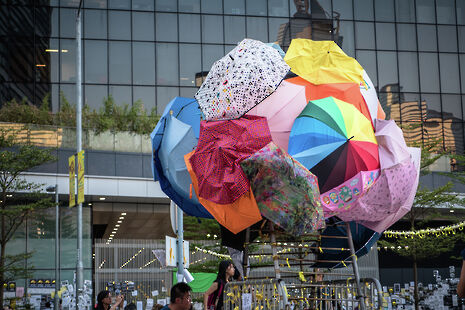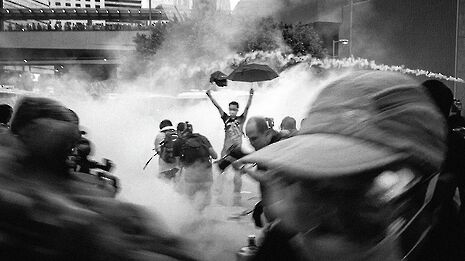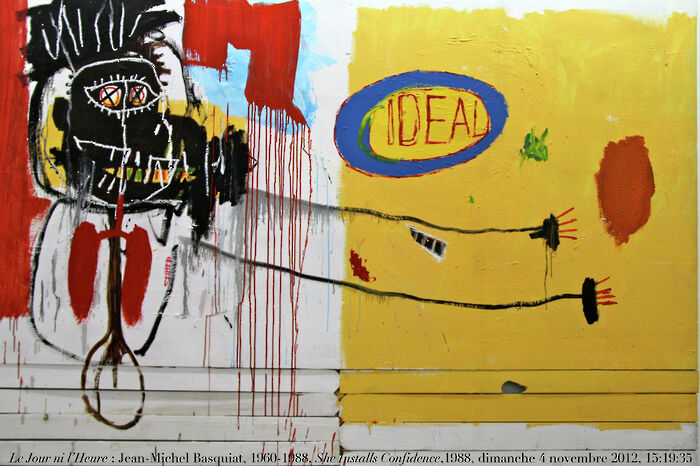Contemporary art and Hong Kong
Alice Garner leads us through Hong Kong’s burgeoning contemporary art scene in an effort to shed light on the city’s paradoxical identity

When people hear that I have lived between Hong Kong and the UK for six years, their first reaction is often intrigue: they are interested to learn about Hong Kong identity, how it relates to mainland China, the island’s colonial past following the 1997 hand-over, and of course whether the stereotypes that it is a very cramped and commercial place to live are true.
By far the best advice I can give to anyone who wants to understand this fascinating city better is to learn more about its contemporary art scene, which explores all of these issues. What constitutes Hong Kong identity has been an important theme for its post-80s generation of artists; a result of experiencing the hand-over during their formative teenage years when their nationality changed from ‘British National (Overseas)’ to ‘Chinese’ overnight.
One such artist is South Ho, whose piece Defence and Resistance 2013 comments on cultural effacement in Hong Kong as a result of increasing mainland influence, a concern shared by many. This can be seen from the resistance in some parts of Hong Kong to government initiatives seeking to replace Cantonese with mainland China’s Putonghua as the main language of teaching in Hong Kong’s schools.
The piece features inkjet prints of Ho building a wall around himself to provide protection from the increasing mainland influence. However, the wall also restricts his mobility. He thus presents the paradox felt by many Hong-Kongers between wanting to protect the separate culture Hong Kong developed as a British colony but also the fear that in protecting this they will miss out on the benefits stronger ties with mainland China could bring. Spray-painted onto Ho’s wall is “Made in Xianggang”: the use of the Putonghua “Xianggang” raises the question of whether the language initiatives will render Cantonese obsolete.
Much of Hong Kong’s contemporary art comments on the status of Hong Kong as a former British colony. The dichotomy colonialism represents in the Hong Kong psyche is explored in Magdalen Wong’s 2017 piece Blanket. In this piece an old British army wool blanket attached to a rope is pulled across the floor. The association of the blanket with a ‘security blanket’ evokes positive feelings of sentimentality and dependency that some associate with colonialism, whereas the use of a military item, the resemblance of the rope to a noose, and the slowness of the blanket’s movement in contrast with the fast-paced nature of Hong Kong life, all suggest the darker side of colonialism.
“With little government support for contemporary art in Hong Kong, many feel discouraged about its future.”
The use of art for social intervention has also emerged as an important theme in Hong Kong contemporary art. Many of Hong Kong’s contemporary artists took part in the 2014 Umbrella Movement, a large-scale civilian occupation of many of Hong Kong’s key areas demanding true universal suffrage. Art works created at the occupation site included Umbrella Patchwork, a canopy created by 50 visual arts students from Hong Kong Baptist University who sewed together over 250 broken umbrellas that had been used by protesters to shield themselves from pepper spray and tear gas, as well as Umbrella Man, a three-metre statue of wooden slats of a figure holding an umbrella.

Artists are now creating pieces that comment on the legacy of the movement and how it has come to be viewed in its aftermath. Chloë Cheuk’s 2016 piece If the Moment Came features an installation of a wired glass window from which the projection of a Kendama ball tries to break out. Every time the ball strikes against the window it lifts but then falls – its attempts to escape are useless.
Cheuk’s inspiration came from when she was conducting field recording at the Umbrella Movement protest site and noticed a parallel between the persistence of the sound of children playing with a Kendama nearby and the persistence of the protestors trying to break into the Legislative Council. Her piece thus reflects how many have come to see the Umbrella Movement as futile in achieving its aims, blaming the involvement of too many disparate groups, each projecting their own grievances onto the movement and obscuring its original demands.
The nature of more everyday life in Hong Kong is also explored in contemporary art: Chilai Howard’s piece xxxm from 2017 features many silicone figures compressed together within a glass tank to illustrate the close proximity within which people live in Hong Kong. Other contemporary artists question Hong Kong’s highly consumeristic culture with its socially acknowledged standards of luxury. Ko Sin Tung’s piece Every Unit 2017 features a video which highlights different parts of an empty apartment interior while accompanying audio compels the viewer to imagine that various pieces of furniture and appliances described are really there. Each viewer is thus encouraged to consider their ideal domestic space.
With little government support for contemporary art in Hong Kong, many feel discouraged about its future. Museums under the Leisure and Cultural Services Department rarely present contemporary art shows and one councillor has even suggested that “any artwork with political or insulting content is not art.” In this context, these artists’ commitment to Hong Kong and its contemporary art scene is particularly important. Their art gives them a voice to comment on the problems they persevere with, and thus to improve, the city
 News / SU reluctantly registers controversial women’s soc18 December 2025
News / SU reluctantly registers controversial women’s soc18 December 2025 Features / Should I stay or should I go? Cambridge students and alumni reflect on how their memories stay with them15 December 2025
Features / Should I stay or should I go? Cambridge students and alumni reflect on how their memories stay with them15 December 2025 News / Dons warn PM about Vet School closure16 December 2025
News / Dons warn PM about Vet School closure16 December 2025 News / Cambridge study finds students learn better with notes than AI13 December 2025
News / Cambridge study finds students learn better with notes than AI13 December 2025 News / CUP announces funding scheme for under-represented academics19 December 2025
News / CUP announces funding scheme for under-represented academics19 December 2025









